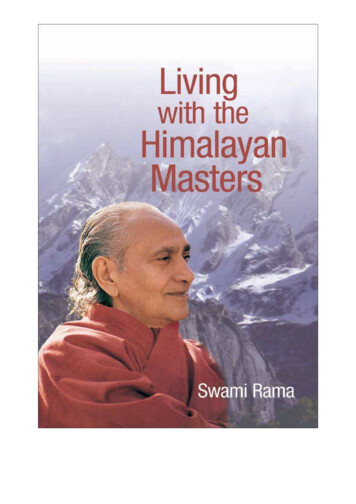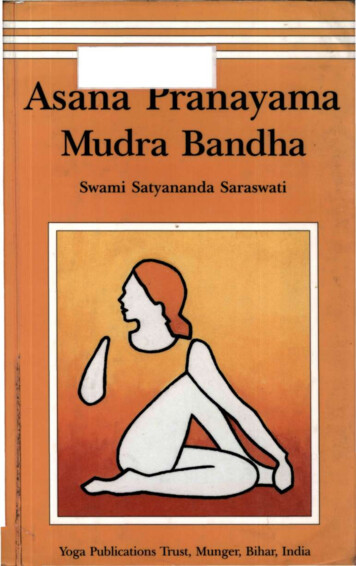
Transcription
ContentsIntroduction by Pandit Rajmani TigunaitAt Thy Lotus Feet—Sri Swami RamaI. Spiritual Education in the HimalayasThe Sacred HimalayasMy Gurudeva and ParentsMy Master and the Prince SwamiFootprints of DelusionHow We Live in the CavesII. The Master TeachesLearning to GiveHow a Master Tests His StudentsAn All-Night Journey Through the ForestCrossing a Flooded RiverMy Offering to My MasterLonelinessMaya, the Cosmic VeilBitter Truth with Blessed EffectsYou Teach Others but Deprive MeDiscipline Is a MustBlessings in a CurseIII. The Path of Direct ExperienceDirect Experience Alone Is the MeansReal Knowledge Removes SufferingA Mantra for HappinessA Mantra for BeesMisuse of MantraI Receive a BeatingUnique Practice of TantraYou Have Committed Many TheftsA Firethrower SwamiAn Astounding MysticMy Mother TeacherAn Ageless YogiIV. Learning HumilityEgo and Vanity Are in VainMy Swollen EgoCultivating Inner QualitiesI Thought I Was PerfectPractice Makes PerfectThe Sage from the Valley of FlowersV. Conquering FearThe DevilMistaken for a GhostMy Fear of SnakesIn a Tiger’s CaveVI. The Path of RenunciationMy Whole Being Is an EyeMy Experience with a Dancing GirlTransformation of a MurdererA Lesson in Non-attachmentTaste the World and Then RenounceJewels or Fire?My First Days as a SwamiA Constant PersecutionLiving on a Mount of PebblesTemptations on the PathShould I Get Married?Spiritual Dignity Is Also VanityA Miserable ExperimentCharms of the WorldTwo Naked Renunciates2
In the World and Yet AboveTo Lose Is to GainVII. Experiences on Various PathsA Renowned Lady SageWith My Heart on My Palms and Tears in My EyesKarma Is the MakerIn the Ashram of Mahatma Gandhi“Not Sacrifice but Conquest”—TagoreSetting History StraightMaharshi RamanMeeting with Sri AurobindoThe Wave of BlissThree Schools of TantraThe Seven Systems of Eastern PhilosophySomaVIII. Beyond the Great ReligionsA Christian Sage of the HimalayasMy Meeting with a Jesuit SadhuJesus in the HimalayasA Vision of ChristJudaism in YogaI Belong to None but GodIX. Divine ProtectionProtecting ArmsLost in the Land of DevasThe Land of HamsasAn Atheistic SwamiAn Appointment with DeathX. Powers of the MindLessons on the SandsTransmutation of MatterWhere Is My Donkey?Who Was That Other Gopinath?An Experience with a PsychicXI. Healing PowerMy First Exposure to the Power of HealingMy Master Sends Me to Heal SomeoneUnorthodox Ways of HealingHealing in a Himalayan ShrineAt the Feet of the MastersXII. Grace of the MasterGuru Is a Stream and a Channel of KnowledgeA Weeping StatueMy Master’s PhotographWho Can Kill the Eternal?Half “Here,” Half “There”How a Young Widow Was RescuedMy Master Saves a Drowning ManShaktipata—Bestowing BlissMy Grandmaster in Sacred TibetPreparing to Tear the VeilXIII. Mastery over Life and DeathBirth and Death Are but Two CommasAttitudes Toward DyingThe Techniques of Casting Off the BodyLiving in a Dead BodyMy Master Casts Off His BodyXIV. Journey to the WestA Doctor’s Recurring VisionTransformation in the CaveWays of East and WestOur TraditionGlossary3
IntroductionBy Pandit Rajmani TigunaitSri Swami Rama took me under his wing in 1976, and from that time on every minute of the twenty years Ilived with him was a time of learning. Now that he is no longer in his physical body, I look back and realizehow skillfully he filled my every breath with the living presence of the masters who were such an integralpart of his own life. In continuous waves he nourished my mind and heart with the perennial knowledge andlove of the lineage of the sages. Today, with awe and gratitude, I ask myself: After having him as mymaster, is there anything yet to be achieved?One of the most blessed and richest periods of my life was in 1985, when at Swamiji’s behest I began totranslate Living with the Himalayan Masters into Hindi, my native language. Every evening, when I showedhim that day’s translation, Swamiji told me the untold part of the story, and I soon realized he was using thetranslation as an excuse for me to glimpse the inner life of the sages he had written about, and to absorbtheir teachings. Every episode brought a revelation, which I was able to assimilate only through the grace ofSri Swamiji and the masters who speak through this book. Living with the Himalayan Masters is theembodiment of Swamiji’s life, his spiritual journey, and his experiences with the masters of differenttraditions. He addresses the issues that all of us confront at least once in our lifetime, and shares hisexperiences in such a simple and loving manner that they become a part of us.At the mundane level, this book shows us who we are and what steps we must take to be happy andsuccessful. It inspires us to work hard and have faith in our own self-effort. At the spiritual level, itintroduces us to our own mystical and esoteric self as we encounter the adepts hidden in the caves andmonasteries of the Himalayas and other remote parts of India, Tibet, Nepal, Sikkim, and Bhutan.Spiritual books, especially those of an autobiographical nature, often give the impression that theexperiences and spiritual achievements of the masters are beyond our reach. Swamiji, however, putsmiracles and mysticism in an entirely different light. Reading it, we feel that he is one of us. He is a youngboy, full of mischief. He is a teenager, full of curiosity and adventurous zeal. He is a seeker, with certainstrengths and weaknesses. Just like us, he sometimes fails to distinguish the fakes from genuine masters,mistaking magic for spiritual achievement. At one time, for example, attracted by the magical power andglamorous life of sorcerers and low-grade tantrics, he even considers abandoning his master for anotherteacher. His human traits are so familiar to us that in reading about them his journey becomes our journey.The stories in this book infuse our hearts with overwhelming gratitude for the sages who selflessly sharetheir boundless love and yet remain unrecognized by the multitude. Swamiji is one of them. While he livedamong us he lectured, wrote books, and established large charitable organizations, but very few of usperceived his spiritual stature. In the last phase of his life those who were near to him and had “eyes to see”came to know that Swamiji was master of every esoteric practice he mentions in this book, but they neverknew how and when he practiced them.Swamiji discouraged a belief in miracles, yet every moment of his life was filled with miracles. No onewho came near him ever went away empty-handed. His gifts were of different shapes, sizes, and weights—upon touching his feet, a businessman might be blessed with prosperity, a sick man with health, and astudent with knowledge. Some understood what they had received; others did not. Now I look back andwonder at how beautifully he unveiled the spiritual mysteries while skillfully hiding his identity as one ofthe greatest sages from the Himalayan peaks.Swami Rama was fully established in his own self-nature. A playful child, a carefree adolescent, a gentlesage, a tactful adult spontaneously manifested in him. For him past and future did not exist—he alwayslived in the present, and the circumstance of the moment called forth whatever persona would help andguide those who were with him. Transformative energy emanated from him. If he stayed for a time in arocky, barren land, a beautiful rock garden would emerge; if he stopped to speak to a woman suffering fromchronic depression, her face would light up and the years would drop away.4
To Swamiji, nothing was useless; everything had purpose and meaning. He once put rocks and pebblesaround an odd-looking septic vent pipe and artfully placed a few stumps around it; the resulting “sculpture”looked like a holy man sitting in meditation, and visitors kept a respectful distance. He was very fond ofcactus. He had a huge collection in India and a smaller one in the States. One day I asked him, “Swamiji,why do you love cactus so much?” He said, “I am in the habit of tending those who are full of thorns andare discarded by everybody. It gives me great joy when I see them blossom.”I remember my own life. Before 1976 I was like a speck of dust drifting along the roadside. Then oneday Swamiji picked me up and transformed me into living pollen. With his loving touch I became anintegral part of that garden which the sages cultivate. Today I have been given the honor and privilege ofwriting an introduction to this classic work, but I hope you will understand that my attempt to do so is like aflower’s attempt to describe the gardener and his work—work which far exceeds the flower’sunderstanding. What I received directly from Swamiji and what I learned about him by visiting placeswhere he did his sadhana, however, gives me the confidence to say that the stories in this book representonly the tip of the iceberg.Living with the Himalayan Masters has its own spirit. I have read and pondered over it countless times.And each time I have found something new, something that was just what I needed at that level of mydevelopment. The book speaks to each reader at the personal level. I must not try to tell you what I think itis about, because by doing so I might put a veil between you and its message. In these pages you willexperience Swamiji’s presence and the presence of other great masters. May you bask in their grace andreceive just what you need.ISpiritual Education in the HimalayasCHILDHOOD IS THE FOUNDATION STONE UPON which stands the whole life structure. The seed sown inchildhood blossoms into the tree of life. The education which is imparted in childhood is more importantthan the education which is received in colleges and universities. In the process of human growth, properguidance along with environmental learning is important.The Sacred HimalayasThe Himalayan ranges extend over almost 1,500 miles in length. Mount Everest, towering upward over29,000 feet on the border of Nepal and Tibet, is the highest of all the mountains in the world. Persians,Indians, Tibetans, and Chinese have all written about the grandeur and beauty of these mountains. The wordHimalaya comes from Sanskrit words: hima, meaning “snow,” and alaya, meaning “home”—the home ofsnows. I would like to make you aware that the Himalayas are not merely the home of snow, but that theyhave also been a stronghold of yogic wisdom and spirituality for millions of people, regardless of theirreligious beliefs. This ancient and rich tradition still exists there today as these unique mountains continue towhisper their spiritual glory to all who have an ear to hear.I was born and brought up in the valleys of the Himalayas. I roamed among them for more than four anda half decades and was educated by their sages. I met the masters who live and travel there, studied at theirfeet and experienced their spiritual wisdom. From the Punjab Himalayas to the Kumayun and GarhwalHimalayas, from Nepal to Assam, and from Sikkim to Bhutan and Tibet, I traveled to those forbidden placeswhich are virtually inaccessible to tourists. I climbed to a height of 19,000 to 20,000 feet without the help ofan oxygen kit or modern equipment. Many times I did not have food and became unconscious, tired andsometimes wounded, but always, one way or another, I found help during such occasions.For me, the Himalayas are my spiritual parents and living there was like living in the lap of a mother.She brought me up in her natural environment and inspired me to live a particular style of life. Once when Iwas fourteen years old, an unknown sage blessed me and gave me a leaf of bhoja patra, the paper made ofbark on which the ancient scriptures were written. On it he inscribed, “Let the world be little with you. Letyou be on the path of spirituality.” It is still in my possession.5
Let the world be little with you.Let you be on the path of spirituality.Awadhoot, Gangotri, 1939The love I received from the sages is like the perennial snows which form the silvery glaciers of theHimalayas and then melt into thousands of streams. When love became the lord of my life, I became quitefearless and traveled from one cave to another, crossing streams and mountain passes surrounded by snowblanketed peaks. In all conditions I was cheerful, searching for the hidden sages who preferred to remainunknown. Every breath of my life was enriched with spiritual experiences which may be difficult for manyothers to comprehend.That gentle and amiable sage of the Himalayas had only one entrancing theme: love—for nature, love—for creatures, and love—for the Whole. The Himalayan sages taught me the gospel of nature. Then I startedlistening to the music coming from the blooming flowers, from the songs of the birds, and even from thesmallest blade of grass and thorn of the bush. In everything lives the evidence of the beautiful. If one doesnot learn to listen to the music of nature and appreciate her beauty, then that which impels man to seek loveat its fountain may be lost in the remotest antiquity. Do you need psychological analysis to discover innature the source of so much happiness, of so many songs, dreams, and beauties? This gospel of naturespeaks its parables from the glacial streams, the valleys laden with lilies, the forests covered with flowers,and the light of stars. This gospel reveals that emphatic knowledge through which one learns truth andbeholds the good in all its majesty and glory.When one learns to hear the music of nature and appreciate her beauty, then his soul moves in harmonywith its entire environment. His every movement and every sound will surely then find its due place inhuman society. The mind of man should be trained to love nature before he looks through the corridor of hislife. Then a revelation comes peeping through with the dawn. The pain and miseries of life disappear withthe darkness and the mist when the sun rises. Mortality finds its way in the awareness of immortality. Thena mortal being suffers no more from the pangs and sorrows which death seems to shower upon him. Deathhas for ages been a constant source of misery, but at death man learns to become one with the infinite andthe eternal.When one learns to appreciate fully the profundity of nature in its simplicity, then thoughts flowspontaneously in response to the appeals of his delicate senses when they come in contact with nature. Thissoul-vibrating experience, in its full harmony with the perfect orchestra of melodies and echos, reflects fromthe sound of the ripples of the Ganges, the gushing of the winds, the rustling of leaves, and the roar ofthundering clouds. The light of the self is revealed and all the obstacles are removed. He ascends the top ofthe mountain, where he perceives the vast horizon. In the depth of silence is hidden the source of love. Theeye of faith alone can unveil and see the illumination of that love. This music resounds in my ears and hasbecome the song of my life.This discovery of the sages binds the whole of humanity in the harmony of the cosmos. Sages are thesources from which mankind receives knowledge and wisdom to behold the light, truth, and beauty whichshow the path of freedom and happiness to all. They make humanity aware of the mere shadows and vainillusions of this world. With their eyes the unity of the entire universe is best seen.“The truth is hidden by a golden disc. O Lord! Help us in unveiling so that we can see the truth.” Thegospel of love as taught by the Himalayan sages makes the whole universe aware of the fountainhead oflight, life, and beauty.At a young age I sat at the foot of Mount Kailas and drank the glacial waters of Lake Manasarowar.Often I cooked the vegetables and roots grown by Mother Nature at Gangotri and Kedarnath. Living in the6
Himalayan caves was very pleasant, and when I was there I was in the habit of roaming through themountains during the day, taking notes in a haphazard manner, and returning to my cave before darknesswould fall. My diary is filled with descriptions of my experiences with the sages, yogis, and other spiritualleaders of the Himalayas.Temple at KedarnathThis is a land where Sandhya Bhasha was born. Several modern scholars have tried to interpret andtranslate Sandhya Bhasha by calling it “the twilight language.” Actually, the way I was taught this language,it is entirely different from the concept the modern writers have of it. It is a purely yogic language, spokenby only a few fortunate yogis, sages, and adepts. Philosophically and ideally, it is very similar to Sanskrit,for every word of Sandhya Bhasha flows full of meaning from its root sound. Sandhya Bhasha can be usedonly for the discussion of spiritual matters and contains no vocabulary for the business affairs of the world.When the sun weds with the moon, when the day weds with the night, and when ida and pingala [the leftand right energy channels of the human body] equally flow, that union is called sandhya or sushumna.Sushumna is the mother from whose womb was born the language Sandhya Bhasha or twilight. During thatperiod of sushumna the yogi derives the greatest joy that anyone can consciously experience. When such ayogi speaks with other adepts, then they converse in this language, which is hard for others to understand.Knowledge of the appropriate way of chanting the Vedic verses is slowly diminishing because the grammarof the Vedas is different from the Sanskrit language. (The grammar of the Vedas is called Nirukta.)Similarly, the grammar of Sandhya Bhasha is completely based on sounds and is diminishing. As themusicians of classical music can make notes from sounds and their pitches, so the notes can be made fromthe sounds used in Sandhya Bhasha. It is called “the language of devas” [gods].When one sits in the mornings and evenings on the tops of the mountains, he can see beauty all around.If he is a spiritual man, he can understand how this beauty is an inseparable aspect of the Lord, whoseattributes are Satyam, Shivam, and Sundaram—truth, eternity, and beauty. This is the land of devas. In theHimalayas, dawn (usha) and twilight (sandhya—when the day weds the night) are not mere momentscreated by the rotation of the earth, but have a deep symbolic meaning.Morning, afternoon, evening, and night each have their own beauty which no language can everdescribe. Many times a day the mountains change their colors, because the sun is at the service of thesemountains. In the morning they are silvery, at noon they are golden, and in the evening they look red. Ithought that my own mother was dressing to please me in many different-colored saris. Do I havevocabulary to explain this beauty through the language of the lips? It is only the language of the heart inwhich I can speak, but the words do not roll down through my lips.I can give you only a glimpse of these beautiful mountains. Their beauty is splendid and beyonddescription. The morning environment in the Himalayas is so calm and serene that it leads an aspirantspontaneously to silence. That is why the people of the Himalayas become meditators. Nature strengthenedthe schools of meditation. When I lived in my cave, Usha (dawn), holding the rising sun in her palm, wouldawaken me every morning, as though my mother were standing before me. The rays of the sun penetratedgently through the entrance. (In the cave there lived several yogis studying the wisdom of the Upanishads atthe feet of the master.)7
Shivling, towering between Gangotri and GomukhIn the evening when the weather clears and the sun breaks through the clouds, it seems as though themighty Painter were pouring out millions of colors on the snowy peaks, creating paintings which couldnever be duplicated by the brushes and colors of the tiny fingers of artists. Any art that exists in Tibet,China, India, and Persia has some influence of the Himalayan beauty on it. A few times I too tried to paint,but I stopped using my brushes because my paintings seemed to be mere scribbles drawn by a child. Beautyremains bound within the limitations of human realms if it is not appreciated heartily. When one becomesaware of the higher level of beauty which projects itself through nature, he becomes a true artist. When anartist becomes aware of that fountain from which arises all beauty, then instead of painting, he startscomposing poems. The brush and colors do not have access to that finest level of consciousness. Spiritualbeauty needs to be expressed on increasingly deeper and more subtle levels.The most ancient travelers of the Himalayas are the clouds which roll gently from the Bay of Bengal.Rising from the ocean, these monsoon clouds travel toward the snowy peaks of the Himalayas, hug them,and return roaring to the plains, laden with pure snowy waters. They shower their blessings and bestowthem upon the soil of India. Kalidasa, a great Sanskrit poet known as “the Shakespeare of the East,”composed many poems about these clouds. Meghadoota is a solitary example of an excellent collection ofthese poems. In these poems Kalidasa used the clouds as messengers to deliver his message to his beloved,who was captive in the Himalayas. The Ramayana and Mahabharata, famous Indian epics, are full ofpraises describing pilgrimages to the Himalayas. Even modern poets of Hindi and Urdu like Prasad andIckbal could not resist composing poems on the Himalayan beauty. Many Sanskrit poems, such asMahimna-stotra, are sung as though a traveler were going up and coming down from the Himalayas. I alsoused to compose poems and sing, although I was not a good poet or singer. The classical music of Indiaborrowed ragas like Pahari from the melodious tunes sung by the girls from the tops of the mountains. TheHimalayas remain replete with mysteries for poets, artists, musicians, and travelers, but they reveal theirmost important message only to those who are prepared. Mystics alone can unveil the real secrets of thesewondrous mountains.I used to roam in the mountains with my pet bear, who was very loyal to me. He was fond of me andbecame very possessive. He wouldn’t hurt anyone, but would knock down anyone who came near me. I8
called him Bhola and he was my finest company during those days. For eleven years he lived near my caveand would always wait for me to come out. My master did not approve of my growing attachment to this petand used to tease me, calling me a bear charmer. In the morning, carrying a long staff to help me inclimbing, I would go to the mountaintops which were four to six miles from my cave. I had my diary, a fewpencils and the bear Bhola with me.After the fifteenth of September it starts snowing in the Himalayas, but I continued my long walks to thenearby mountaintops, singing the hymns of the Divine Mother. Occasionally the thought would flash in mymind that my life belongs to those who follow our tradition. I did not care for my individuality, but wasacutely conscious of the tradition of sages which I followed. Even though I broke the discipline many timesand became rebellious, I was still forgiven. During those days many profound psychological and spiritualexperiences occurred. Sometimes I felt like a king but without any burden of the crown on my head. Nothaving human company or communication brought me great peace and serenity. I realized that nature isvery peaceful. She disturbs only those who disturb themselves, but she teaches wisdom to those who admireand appreciate her beauty. This is especially true in the Himalayas.Many varieties of flowers are found in abundance in these mountains. Those with a poetic imaginationsay that viewed from the snow-covered mountain peaks, these slopes laden with flower beds look like amagnificent vase of flowers which a fully prepared disciple would reverently present to his gurudeva. Iwould sit next to these natural flower beds and gaze into the sky, searching for their Gardener.Among all the flowers grown in the Himalayan valleys, the most beautiful are the lilies and the orchids.Hundreds of varieties of lilies bloom after winter is over and sometimes even before snowfall. There is onevariety of lily which is pink and very beautiful. It grows in June and July at a height of 8,000 to 11,000 feetand is found on the banks of the river Rudra Garo that joins the Ganges at Gangotri. This same variety oflily also grows under the trees at Bhoja Basa.The orchids in the Himalayas are more gorgeous than any other flower. They grow at a height of 4,000to 6,000 feet. The heaviest orchid that I ever found was growing on an oak tree and weighed a little less thanone and a half pounds. Some varieties of these orchids can be found in greenhouses a few miles fromKatmandu, Nepal, but many still remain undiscovered by horticulturists. During the blossoming season oforchids, the buds, in their natural obstinacy, delay blooming and sometimes take six to seven days to open.Orchid flowers are amazingly beautiful and their blooming season lasts for at least two and a half months.The mountain cacti bloom suddenly in the moonlit night. They are shy to the sun’s rays, and before thesun rises their petals withdraw their blooming beauty, never to bloom again. I know of more than twentyfive varieties of succulents and cacti in the Himalayas which are used for medicinal purposes. I was told thatthe soma creeper comes from the succulent family and grows at the height of 11,000 to 18,000 feet.Among the great variety of flowers in the Himalayas there are more than one hundred and fifty varietiesof rhododendron. The most striking of this species is blue and white. Pink and red varieties are common,and there is another variety which has multi-colored petals. In the summer, sometimes an entire valley isladen with rhododendron flowers.The king of all the Himalayan flowers is the himkamal, or “snow lotus,” a very rare flower. One day as Iwas wandering through the mountains I saw a single blue himkamal as big as a saucer, growing frombetween two rocks and half-buried in snow. I started looking at it and my mind entered into a dialogue withthis beautiful snow lotus. I said, “Why are you here all alone? Your beauty is meant to be adored. Youshould give yourself to someone before your petals fall and return to the dust.”As the breeze blew its stem, it shook and then bent toward me, saying, “Do you think I am lonely beingall alone? All alone means all in one. I enjoy these heights, the purity, the shelter of the blue umbrellaabove.”I wanted to pick the flower and considered pulling it out and taking the whole plant to my master. Icompared my own life to this lotus and said like an irresponsible, joyous child, “What will happen to you ifI crush your petals?”The lotus replied, “I will be glad, for my fragrance will radiate everywhere and the purpose of my lifewill be fulfilled.”I pulled the lotus out by its roots and took it to my master, but he was not appreciative. He had neverliked to use flowers and their fragrance except on a few occasions when he instructed me to collect flowers9
from the forest for worship. That was the last day that I ever picked a flower. I felt that I had been deprivingMother Nature by snatching her child from her lap. I never picked a flower again. Beauty is to be admiredand not to be used, possessed, or destroyed. Aesthetic sense develops when one starts appreciating thebeauty of nature.To satisfy and fulfill my desire to be all alone I wandered here and there, admiring nature just by beingwith her. Sometimes I would go down to the snowy streams and look at the ripples kicking each other asthey moved forward. The rivers and streams running from the tops of the glaciers looked like many longlocks of hair. The music created by the streams is quite exhilarating. I would compare the stream of life withthese ever-flowing streams and watch how a mass of water running toward the ocean would not leave a gap.The currents would never turn back, but another mass of water would fill the gap. There was alwayscontinuity. Those streams are like the perennial flow of life. For hours I would watch these snowy streamsflowing from the glaciers and waterfalls. Both banks of the streams glittered like silver on moonlit nights.Living in that part of the Himalayas where the Ganges flows, I would stay seated on its rocky banks andgaze at the blue sky and the clear moon, which paled its light on the sands. I watched the twinkling lightscoming from the small homes of the distant villages, and when the clouds parted I saw the sky glitteringwith the lamps of a million stars. This grand assembly and long procession of the stars is beyond humanimagination. Below on the earth, the peaks of the Himalayas silently enjoyed this fair of stars. Some of themseemed as though they were playing hide and seek among the mountain peaks. In all directions, themountain peaks and snowy streams were illuminated with that milky light emanating from the starrymultitude which I remember even today. In the evenings mist formed a thick white quilt over the Gangesbetween the two ridges of snowy peaks, and before sunrise a layer of mist would cover the Ganges like awhite blanket. It seemed as though a sleeping serpent were snoring from beneath it. The rays of the risingsun rushed to drink these holy waters as eagerly as I rushed to bathe in the Ganges every morning. Themountain water was crystal clear, soothing to the eyes, and stimulating to the senses.There are many rivers that flow from the great Lake Manasarowar at the foot of Mount Kailas, but of allthe rivers which have their source in the Himalayan mountains, the Ganges is unique. When the Gangesflows from its sources in the glaciers of Gangotri, it carries in its water a variety of minerals which havenutritional and therapeutic value. Skin diseases are rarely found among villagers who live on the banks ofthe Ganges. A bottle of Ganges water is kept in every home and practically all of the villagers give it to adying person to drink.This glacier at the base of the Bhagirithi Pea
Sri Swami Rama took me under his wing in 1976, and from that time on every minute of the twenty years I lived with him was a time of learning. Now that he is no longer in his physical body, I look back and realize how skillfully he filled my every breath with the living presence of the masters who were such an integral part of his own life.










